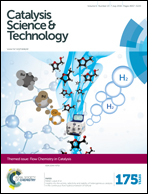Methane to methanol over copper mordenite: yield improvement through multiple cycles and different synthesis techniques†
Abstract
Copper mordenite was used for the conversion of methane to methanol in a cyclic operation. Repeated cycling was possible using catalysts having different loadings prepared via aqueous ion exchange using copper(II) acetate (Cu-MORA) and solid state ion exchange using copper(I) chloride (Cu-MORS). For Cu-MORA, the yield increased by at least 30% on the second cycle and remained constant afterwards. Linear combination fitting of the XANES identified a similar increase in the fraction of CuI formed upon reacting with methane on the second cycle. For Cu-MORS residual chlorine initially hindered the production of methanol. Successive cycles removed chlorine and yielded significantly more methanol per copper than Cu-MORA. Over successive cycles of Cu-MORS, the fraction of the CuII species that was reduced to CuI upon reacting with methane correlated well with the amount of methanol produced. Although commonly done, analyzing only one reaction cycle is not representative of the long-term performance of methane to methanol over copper mordenite. Copper species equilibrate with cycling.


 Please wait while we load your content...
Please wait while we load your content...